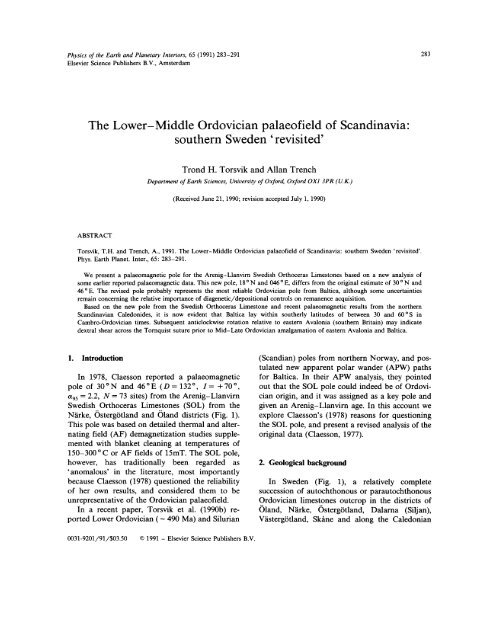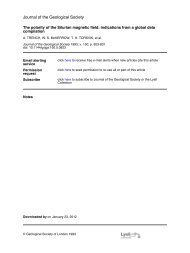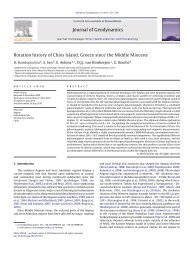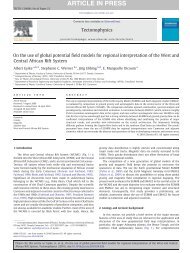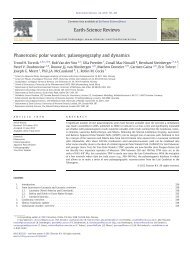The Lower—Middle Ordovician palaeofield of Scandinavia: southern ...
The Lower—Middle Ordovician palaeofield of Scandinavia: southern ...
The Lower—Middle Ordovician palaeofield of Scandinavia: southern ...
You also want an ePaper? Increase the reach of your titles
YUMPU automatically turns print PDFs into web optimized ePapers that Google loves.
Physics <strong>of</strong> the Earth and Planetary Interiors, 65 (1991) 283—291 283<br />
Elsevier Science Publishers B.V., Amsterdam<br />
<strong>The</strong> <strong>Lower—Middle</strong> <strong>Ordovician</strong> <strong>palae<strong>of</strong>ield</strong> <strong>of</strong> <strong>Scandinavia</strong>:<br />
<strong>southern</strong> Sweden ‘revisited’<br />
Trond H. Torsvik and Allan Trench<br />
Department <strong>of</strong>Earth Sciences, University <strong>of</strong> Oxford, OxfordOX] 3PR (U.K)<br />
(Received June 21, 1990; revision acceptedJuly 1, 1990)<br />
ABSTRACT<br />
Torsvik, T.H. and Trench, A., 1991. <strong>The</strong> <strong>Lower—Middle</strong> <strong>Ordovician</strong> <strong>palae<strong>of</strong>ield</strong> <strong>of</strong> <strong>Scandinavia</strong>: <strong>southern</strong> Sweden ‘revisited’.<br />
Phys. Earth Planet. Inter., 65: 283—291.<br />
We present a palaeomagnetic pole for the Arenig—Llanvirn Swedish Orthoceras Limestones based on a new analysis <strong>of</strong><br />
some earlier reported palaeomagnetic data. This new pole, 180 N and 046°E,differs from the original estimate <strong>of</strong> 30 °N and<br />
46 °E.<strong>The</strong> revised pole probably represents the most reliable <strong>Ordovician</strong> pole from Baltica, although some uncertainties<br />
remain concerning the relative importance <strong>of</strong> diagenetic/depositional controls on remanence acquisition.<br />
Based on the new pole from the Swedish Orthoceras Limestone and recent palaeomagnetic results from the northern<br />
<strong>Scandinavia</strong>n Caledonides, it is now evident that Baltica lay within southerly latitudes <strong>of</strong> between 30 and 60 ~S in<br />
Cambro-<strong>Ordovician</strong> times. Subsequent anticlockwise rotation relative to eastern Avalonia (<strong>southern</strong> Britain) may indicate<br />
dextral shear across the Tornquist suture prior to Mid—Late <strong>Ordovician</strong> amalgamation <strong>of</strong> eastern Avalonia and Baltica.<br />
1. Introduction (Scandian) poles from northern Norway, and postulated<br />
new apparent polar wander (APW) paths<br />
In 1978, Claesson reported a palaeomagnetic for Baltica. In their APW analysis, they pointed<br />
pole <strong>of</strong> 30°N and 46°E (D=132°, 1= +70°, outthattheSOLpolecouldindeedbe<strong>of</strong>Ordovia<br />
95 = 2.2, N = 73 sites) from the Arenig—Llanvirn cian origin, and it was assigned as a key pole and<br />
Swedish Orthoceras Limestones (SOL) from the given an Arenig-Llanvirn age. In this account we<br />
Närke, Ostergotland and Oland districts (Fig. 1). explore Claesson’s (1978) reasons for questioning<br />
This pole was based on detailed thermal and alter- the SOL pole, and present a revised analysis <strong>of</strong> the<br />
nating field (AF) demagnetization studies supple- original data (Claesson, 1977).<br />
mented with blanket cleaning at temperatures <strong>of</strong><br />
150—300°Cor AF fields <strong>of</strong> l5mT. <strong>The</strong> SOL pole,<br />
however, has traditionally been regarded as 2. Geological background<br />
‘anomalous’ in the literature, most importantly<br />
because Claesson (1978) questioned the reliability In Sweden (Fig. 1), a relatively complete<br />
<strong>of</strong> her own results, and considered them to be succession <strong>of</strong> autochthonous or parautochthonous<br />
unrepresentative <strong>of</strong> the <strong>Ordovician</strong> <strong>palae<strong>of</strong>ield</strong>. <strong>Ordovician</strong> limestones outcrop in the districts <strong>of</strong><br />
In a recent paper, Torsvik et al. (1990b) re- Oland, Närke, Ostergotland, Dalarna (Siljan),<br />
ported Lower <strong>Ordovician</strong> (— 490 Ma) and Silurian Vastergotland, Skáne and along the Caledoman<br />
0031-9201/91/$03.50 © 1991 — Elsevier Science Publishers BY.
284 T.H. TORSVIK AND A. TRENCH<br />
k~_~-” 6’Q~\ 1 ~LAND<br />
2 NARKE<br />
3 öSTERGOTLAND<br />
7 4 DALARNA<br />
5 JAMTLANQ<br />
N<br />
6 VESTERGOTLAND<br />
7 sxA,i~<br />
E1O~<br />
Fig. 1. <strong>Ordovician</strong> sampling areas (numbered 1 to 7) in <strong>southern</strong> Sweden (Claesson, 1977) together with the geographic locations <strong>of</strong><br />
some selected palaeomagnetic results portrayed in Fig. 4. Arrows represent local declination values. For the Swedish areas,<br />
declinations represent bedding-corrected component I directions. Symbols are as follows: C = Seiland Igneous Province (component<br />
C, — 490 Ma; Torsvik et al., 1990b); BD = BAtsfjord Dykes (Kjøde et al., 1978—Late Precambrian, 640 Ma, or possible Late<br />
Cambrian—Early <strong>Ordovician</strong> overprint); FC = Fen Complex (Poorter, 1972—565—603 Ma); NS = Nexø Sandstone (Prasad and<br />
Sharma, 1978—Lower Cambrian).<br />
front in Jämtland (Thorsiund and Jaanusson, 1960; then used for blanket cleaning <strong>of</strong> remaining sam-<br />
Thorslund, 1962; Lindström, 1971; Bruton et al., pies. Claesson (1978) questioned her overall re-<br />
1985). <strong>The</strong> limestones are <strong>of</strong> only moderate thick- sults, however, owing to their “smeared distribuness<br />
(
LOWER-MIDDLE oRDovIcIAN PALAEOFIELD OF SCANDINAVIA 285<br />
palaeomagnetic data cover seven different areas in nents by least square analysis. We did not con<strong>southern</strong><br />
Sweden (Fig. 1), <strong>of</strong> which the results <strong>of</strong> sider samples which were subjected to blanket<br />
three areas (Närke, Oland and Ostergotland) were cleaning.<br />
published (Claesson, 1978). We have re-examined Figure 2A shows an example <strong>of</strong> thermal demagthese<br />
raw data (Claesson, 1977), examined the netization presented by Claesson (fig. 2A in Claesdemagnetization<br />
behaviour in orthogonal vector son, 1978), and originally interpreted to portray<br />
projections, and calculated remanence compo- ‘continuous’ directional movement during demag-<br />
A<br />
N S N<br />
550<br />
B<br />
ÔG<br />
11.3 _-.. 500°<br />
Ô$TERGOTLM1~<br />
V I<br />
—<br />
/<br />
/ 550°<br />
lmA/M<br />
60°<br />
300°<br />
S 8OmT N S N<br />
/3OmT<br />
/ O.6mA/M<br />
T° OG 200.<br />
I<br />
OSTERGOTLAND<br />
~5mT ]fl 100°<br />
E,Dn<br />
E,E~<br />
C<br />
0<br />
Fig. 2. Examples <strong>of</strong> thermal and AF demagnetization behaviour <strong>of</strong> samples from Ostergotland (A—C) and Oland (D). In stereoplots,<br />
open (closed) symbols represent negative (positive) inclinations. In orthogonal vector projections, open (closed) symbols represent<br />
points in the vertical (horizontal) plane. Note that in (B) only points in the vertical and horizontal plane are plotted from 300 °Cto<br />
5500 C.
286 TH. TORSVIK AND A. TRENCH<br />
netization. When the same data are examined in (Jackson, personal communication, 1990). Hence,<br />
an orthogonal vector projection, however (Fig. the ‘continuous’ demagnetization behaviour de-<br />
2B), a steep downward-dipping component with scribed by Claesson is in part the result <strong>of</strong> an<br />
southeast declination is reasonably defined above instrumental artefact (K.C. Jackson, personal<br />
300°C.<strong>The</strong> intensity at 550°Cis 0.09 mA m’, communication, 1990).<br />
which approaches the sensitivity <strong>of</strong> the spinner Figure 2A,B is a relatively poor example <strong>of</strong><br />
magnetometer (Digico) used in the original study. demagnetization, and in Fig. 2C,D we present<br />
We note that the demagnetization trajectory in the more typical examples <strong>of</strong> AF and thermal be-<br />
300—500°Crange, however, does not point to- haviour. Generally, the directional movements<br />
wards the origin <strong>of</strong> the diagram. Measurements <strong>of</strong> during demagnetization are confined to low fields<br />
the same rocks conducted on a squid magnetome- (temperatures), leaving a well-defined, high-unter<br />
show that this phenomenon can be attributed blocking component above 7.5 mT 200°C’ (Figs.<br />
to the acquisition <strong>of</strong> an induced component (+ X, 2C, D). All palaeomagnetic results from Arenig—<br />
— Y specimen coordinates) during measurement Llanvirn sediments, covering the areas <strong>of</strong> Oland,<br />
TABLE 1<br />
Areal and overall statistics<br />
Area Rock Component In situ Corrected S~)<br />
(°N, °E) age N D I a 95 k D I a95 k<br />
1 Oland Aremg— I 38(7) 136 +68 1.8 164 136 +68<br />
(57.2, 16.9) Llanvirn III 9(6) 025 +71 6.4 66 025 +71<br />
2 Närke Arenig I 8(3) 138 +64 9.4 36 138 +64<br />
(59.1, 15.1) III 5(3) 048 +61 9.7 63 048 +61<br />
3 Oster- Arenig— I 19(3) 135 +64 7.1 24 148 +62 2.8 143<br />
Gdtland Llanvirn III 6(3) 008 +56 11.3 36 340 +73 43.2 3<br />
(58.5, 15.2)<br />
4 Dalarna Arenig— I 3(2) 130 +61 18.7 45 126 +59 21.7 33<br />
(61.1, 14.7) Llanvirn III 2(2) 026 +57 24.7 105 031 +53 21.0 143<br />
5 Jämtland Arenig— I 7(3) 132 +69 17.4 13 148 +60 9.6 40<br />
(62.9, 14.8) Llanvirn III 9(3) 021 +61 10.0 27 030 +69 8.8 36<br />
6 VAster- Arenig— I 16(1) 135 +53 8.2 21 135 +53<br />
Gotland Llanvirn II 55(7) 197 —8 3.9 25 197 —8<br />
(58.3, 13.9) (S Late Llanvirn I 4(1) 340 —52 16.2 33 340 —52<br />
and Mid Liandeio<br />
(5 Early Caradoc I 2(1) 330 —52 26.0 94 330 —52 7<br />
7 Skâne Arenig I 2(2) 135 +53 89.7 10 135 +61 113.0<br />
(55.7, 14) II 5(4) 205 —7 12.6 38 206 —4 17.5 2<br />
III 10(7) 012 +56 10.8 21 013 +58 10.9 2<br />
Final statistics 2 61 134 +63 5.1 173 138 +62 5.1 176<br />
Componentl(R)<br />
Pole: N18, E46 dp/dm = 6/8 (Corrected S<br />
3 21 335 —52 13.4 206 0) 335 —52<br />
Component 11(N)<br />
Pole: N3, E35 dp/dm = 13/18 (Corrected S<br />
2 21 202 —12 18.5 184 202 0) —10 19.0 174<br />
Componentll<br />
Pole: S34, E348 dp/dm = 10/19 (In situ)<br />
Component III 6’ 023 +61 7.6 78 024 +65 10.0 46<br />
Pole: S68. E325 dp/dm = 9/12 (In situ)<br />
D = mean declination; I = mean inclination; a<br />
1.<br />
95 = 95 percent confidence circle; k = precision parameter; S0 bedding; N =<br />
2<br />
specimen<br />
Mean values<br />
(included<br />
calculated<br />
sites) <strong>of</strong><br />
after<br />
areas<br />
converting each area D and I to a common geographic latitude (59°N) and longitude (15 °E).<br />
Sampling locality = 58.30 N and 13.7°E; * Moderate data quality.<br />
Note that the component 1(R) result from Skâne has been excluded in the final statistics owing to unacceptable high a<br />
95.
LOWER-MIDDLE ORDOVICIAN PALAEOFIELD OF SCANDINAVIA 287<br />
Närke, Ostergotland, Dalarna and Jämtland (areas ponent I also passes a fold-test (95% confidence<br />
1—5 in Fig. 1), show the low- and high-unbiocking level), but component III is insignificantly statistitemperature<br />
interplay depicted in Fig. 2. <strong>The</strong>se cally altered. From Dalarna, none <strong>of</strong> the compomagnetizations<br />
are subsequently referred to as nents provided statistically significant fold-tests.<br />
components III (low stability) and I (high stabil- <strong>The</strong> palaeomagnetic results from Vastergotland<br />
ity) respectively. Component I compares fairly and Skàne differ from the remaining areas, most<br />
well with the original mean direction reported by notably owing to strong palaeomagnetic overprint-<br />
Claesson (1978). In Ostergotland, component I ing by southerly and mostly upward pointing repasses<br />
a fold-test at the 99% confidence level manence components. <strong>The</strong>se overprints relate to<br />
(Table 1), whereas component III fails a fold-test the extensive Permo-Carboniferous intrusive activat<br />
the same confidence level. For Jämtland, com- ity. An example is shown in Fig. 3A, in which<br />
EPOCH POtARITY<br />
— ~ • NORMAL VV,Up<br />
I LI REVERSE<br />
CARADOC 9 150~<br />
—458--<br />
ULLHO El<br />
HASLEKE<br />
LLANDELO 3mA/M 400~<br />
B<br />
—468— F{AU.EKO<br />
LLANVPN<br />
—478——<br />
AREN~ 500.<br />
—488— 54<br />
TREMADOC<br />
A<br />
//<br />
_________<br />
~3o/<br />
E , Dn<br />
Fig. 3. Examples <strong>of</strong> thermal demagnetization <strong>of</strong> samples from VAstergotland (A, B, locality HAllekis), together with a tentative<br />
magnetic stratigraphy for the <strong>Ordovician</strong> rocks <strong>of</strong> <strong>southern</strong> Sweden. <strong>The</strong> Arenig—Lianvirn is characterized by reverse polarity (A), a<br />
polarity conforming to Early <strong>Ordovician</strong> (Tremadoc) results from northern Norway (pole C in Fig. 4), but three stratigraphic<br />
positions, onwards from the Late Lianvirn, suggest the presence <strong>of</strong> normal polarity data (B). <strong>The</strong> normal polarity data are found at<br />
the HAllekis and Gullhogen localities.
288 T.H. TORSVIK AND A. TRENCH<br />
both the overprint (150—300°C—notclearly de- with Upper Carboniferous (— 300 Ma) palae<strong>of</strong>ined<br />
in this example), denoted component II and magnetic results from Sweden (Pesonen et al.,<br />
the characteristic I component (400—600°C) are 1989). Components II and III most likely post-date<br />
evident. Additionally, a low-unblocking tempera- folding.<br />
ture component (
LOWER-MIDDLE ORDOVICIAN PALAEOFIELD OF SCANDINAVIA 289<br />
‘3 ~‘°3 ~<br />
0 .~ ~K ~ 0 Q<br />
~ .0 ~<br />
~<br />
a ~. c<br />
z ~ \ ~— a ‘~ u ~<br />
0<br />
-<br />
U)<br />
a<br />
- - -<br />
~e. 0 ~<br />
IA<br />
- a<br />
.~u ~‘0<br />
Z ‘0<br />
~4,1 I ‘\<br />
& ‘\:•L..~ I<br />
‘~. I<br />
-,<br />
~ z (<br />
-.<br />
4 ~ 1<br />
I 0 l~<br />
— 1:1. ,;~. I J z u ~<br />
— a .0 ,_<br />
IL<br />
C<br />
4.<br />
0.<br />
w 0 .~ ~ a<br />
0<br />
a<br />
—~ ~ u<br />
-<br />
I—I ‘0 ~ a<br />
~<br />
~ .~.c !<br />
Z I//a ‘I I<br />
I<br />
0<br />
-<br />
Eoo ~ ~ 00 ~<br />
or—o~°’ a<br />
0.~ K.°~ ~<br />
.—~—-Eo.~ ~ C.)<br />
a<br />
0. C)<br />
___________________________ C.) a<br />
a o —<br />
0<br />
04
290 T.H. TORSVIK AND A. TRENCH<br />
and Mid-<strong>Ordovician</strong> carbonates from Baltica criticism <strong>of</strong> the original manuscript. Norwegian<br />
which do not indicate a warm climate until Late Lithosphere Contribution (113).<br />
<strong>Ordovician</strong> times thus heralding Baltica’s approach<br />
to equatorial latitudes (Jaanusson, 1973;<br />
Webby, 1980; Bruton et al., 1985; Scotese and References<br />
McKerrow, 1990). Importantly, however, Baltica<br />
was ‘inverted’ with respect to its present day geo- Bölau, E., 1972. Genese und Alter der Horste Schonens. Geol.<br />
graphy in Early <strong>Ordovician</strong> times (Fig. 4C, pole Føren. Fbrhandl., 94: 411—422.<br />
C), and therefore the closure <strong>of</strong> the Tornquist Sea, Bruton, DL., Lindström, M. and Owen, A.W., 1985. <strong>The</strong><br />
separating Baltica and eastern Avalonia (Cocks <strong>Ordovician</strong> <strong>of</strong> <strong>Scandinavia</strong>. In: D.G. Gee and B.A. Sturt<br />
(Editors), <strong>The</strong> Caledonide Orogen-<strong>Scandinavia</strong> and Related<br />
and Fortey, 1982) was accompanied by anticlock- Areas. Wiley, Chichester, pp. 273—282.<br />
wise relative rotation and possible intervening Claesson, K.C., 1977. Palaeomagnetic studies <strong>of</strong> Swedish Lower<br />
dextral shear. <strong>The</strong> SOL pole is critical in con- Palaeozoic rocks. Ph.D. <strong>The</strong>sis, University <strong>of</strong> Newcastle,<br />
straining when the bulk <strong>of</strong> this relative rotation<br />
349 pp.<br />
occurred, but is presently hampered by uncertain- Claesson, K.C., 1978. Swedish <strong>Ordovician</strong> limestones: Problems<br />
in clarifying their directions <strong>of</strong> magnetizations. Phys.<br />
ties in the timing <strong>of</strong> remanence acquisition. If the Earth Planet. Inter., 16: 65—72.<br />
remanence is linked to depositional age, then a Cocks, L.R.M. and Fortey, R.A., 1982. Faunal evidence for<br />
substantial part <strong>of</strong> the rotation must have taken oceanic separations in the Palaeozoic <strong>of</strong> Britain. J. Geol.<br />
place during the earliest <strong>Ordovician</strong> (compare re- Soc. Lond., 139: 465—478.<br />
constructions based on pole C and ‘R in Fig. 4C), Jaanusson, V., 1973. Aspects <strong>of</strong> carbonate sedimentation in the<br />
<strong>Ordovician</strong> <strong>of</strong> Baltoscandia. Lethaia, 6: 11—34.<br />
i.e. coeval with the Finnmarkian Orogeny in Jaanusson, V., 1976. Faunal dynamics in the Middle Ordovinorthern<br />
Norway. If remanence originated during cian (Viruan) <strong>of</strong> Baltoscandia. In: MG. Basset (Editor),<br />
subsequent <strong>Ordovician</strong> diagenesis, however, then <strong>The</strong> <strong>Ordovician</strong> System: proceedings <strong>of</strong> a Palaeontological<br />
the rotation indicated in Fig. 4C may have taken Association symposium, Birmingham, 1974, University <strong>of</strong><br />
place throughout <strong>Ordovician</strong> times. Detailed mag- Wales Press and National Museum <strong>of</strong> Wales, Cardiff, pp.<br />
301—326.<br />
netostratigraphic studies are required to resolve Kjøde, J.K., Storetvedt, K.M., Roberts, D. and Gidskehaug,<br />
this issue. Despite uncertainties concerning the A., 1978. Palaeomagnetic evidence for large-scale dextral<br />
remanence age <strong>of</strong> the SOL, the ‘P. pole converges movements along the Trollfjord—Komagelv fault, Finntowards<br />
Middle <strong>Ordovician</strong> poles from eastern mark, north Norway, Phys. Earth Planet. Inter., 16: 132—<br />
Avalonia (McCabe and Channell, 1990; Trench 144.<br />
Lindstrom, M., 1971. Von Anfang, Hochstand und Ende eines<br />
and Torsvik, 1990; Torsvik et al., 1990a). <strong>The</strong> Epikontinentalmeeres, Geol. Rundschau., 60, 419—438.<br />
discordance between the APW paths <strong>of</strong> Baltica McCabe, C.R. and Channell, J.E.T., 1990. Palaeomagnetic<br />
and eastern Avaloma is, therefore, reduced by results from volcanic rocks <strong>of</strong> the Shelve Inlier, Wales:<br />
Mid(?)-<strong>Ordovician</strong> times, and essentially ceases by evidence for a wlde Late <strong>Ordovician</strong> lapetus Ocean in<br />
the Late <strong>Ordovician</strong> when the intervening Britain. Earth Planet. Sci. Lett., 96: 458—468.<br />
Pesonen, L.J., Torsvik, T.H., Bylund, G. and Elming, S-A.,<br />
Tornquist Sea closes.<br />
1989. Crustal evolution <strong>of</strong> Fennoscandia: Palaeomagnetic<br />
Acknowledgements<br />
constraints. In: R. Freeman, M. von Knorring, H.<br />
Korhonen, C. Lund and St. Mueller (Editors), <strong>The</strong><br />
European Geotraverse, Part 5: <strong>The</strong> polar pr<strong>of</strong>ile. Tectono-<br />
Norwegian Research Council for the Humani- physics, 162: 27—49.<br />
Poorter, R.P.E., 1972. Preliminary palaeomagnetic results from<br />
ties and Science (NAVF), National Environmental the Fen carbonatite complex, S. Norway. Earth Planet. Sci.<br />
Research Council (NERC) and Norwegion Geo- Lett., 17: 194-198.<br />
logical Survey (NGU) are thanked for financial Prasad, SN. and Sharma, P.V., 1978. Palaeomagnetism <strong>of</strong> the<br />
support. Logistic assistance from the staff <strong>of</strong> the Nexø sandstone from Bornholm Island, Denmark. Geo-<br />
Hollybush during the course <strong>of</strong> this study is phys. J.R. Astron. Soc., 54: 669—680.<br />
Scotese, CR. and McKerrow, W.S., 1990. Revised World maps<br />
acknowledged. We thank Warren Dransfield for and introduction. In: W.S. McKerrow and C.R. Scotese<br />
his tireless enthusiasm. C. Jackson, H. Perroud (Editors), Palaeogeography and Biogeography, Mem. Geol.<br />
and V. Bachtadse are thanked for constructive Soc. Lond. 12; 1—21.
LOWER-MIDDLE ORDOVICIAN PALAEOFIELD OF SCANDINAVIA 291<br />
Thorslund, P., 1962. Kambro—Siluravlagringar utanfdr Torsvik, T.H., Olesen, 0., Ryan, P.D. and Trench, A., 1990b.<br />
FjAllkedjan, In: N.H. Magnusson, P. Thorslund, F. Brot- On the palaeogeography <strong>of</strong> Baltica during the Palaeozoic:<br />
zen, B. Asldund and 0. Kulling (Editors), Beskrivning till New palaeomagnetic data from the <strong>Scandinavia</strong>n<br />
karta over Sveriges berggrund. Sver. Geol. Unders., Serie B, Caledonides, Geophys. J. Inter., in press.<br />
16: 113—153. Trench, A. and Torsvik, T.H., 1990. Discussion <strong>of</strong><br />
Thorslund, 0. and Jaanusson, V., 1960. <strong>The</strong> Cambrian, Ordo- Palaeomagnetic results from the rocks <strong>of</strong> the Shelve Inlier,<br />
vician, and Silurian in VastergOtland, NArke, Dalarna, and Wales: evidence for a wide Late <strong>Ordovician</strong> lapetus Ocean<br />
JAmtland, Central Sweden. Guide to excursions No. A23 in Britain, by Chad McCabe and James E.T. Channell.<br />
and C18. Intern. Geol. Congress XXI Session Norden, Earth Planet. Sci. Lett., in press.<br />
Stockholm, Slpp. Webby, B.D., 1980. Biogeography <strong>of</strong> <strong>Ordovician</strong> stroma-<br />
Torsvik, T.H., Smethurst, M.A., Briden, J.C. and Sturt, B.A., toporoids. Palaeogeogr., Palaeodimatol., Palaeoecol., 32:<br />
1990a. A review <strong>of</strong> Palaeozoic palaeomagnetic data from 1—19.<br />
Europe and their palaeogeographic implications. In: W.S.<br />
McKerrow and C.R. Scotese (Editors), Palaeogeography<br />
and Biogeography, Mem. Geol. Soc. Lond., 12: 25—41.


